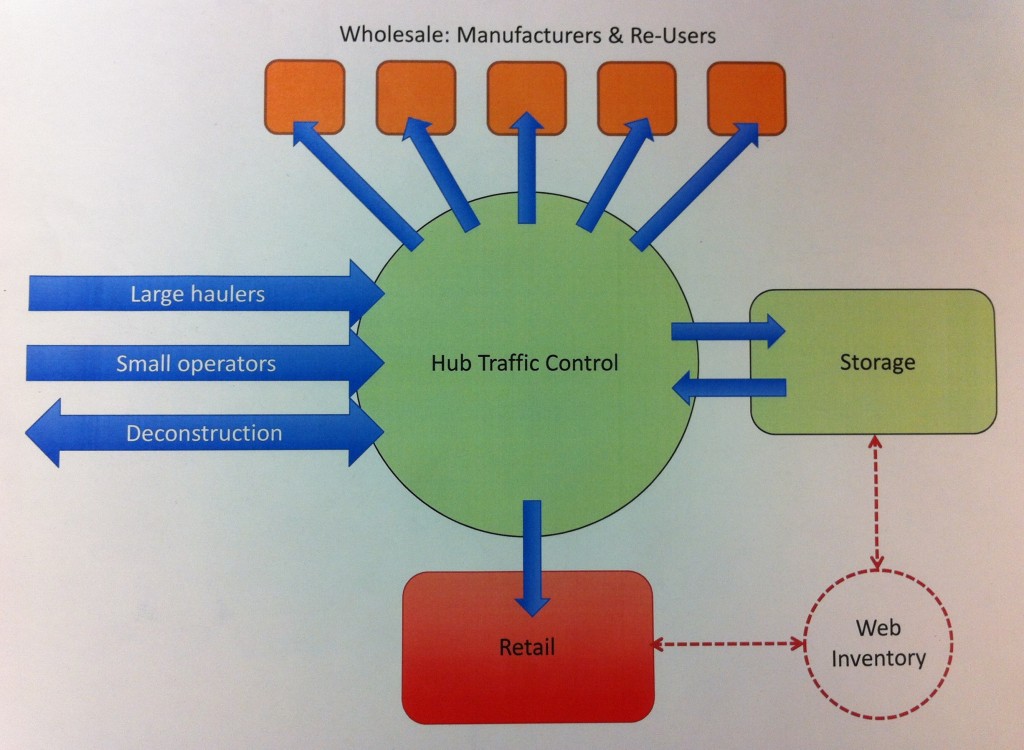Since our first meeting with the City’s Lena, Rachel and Jon, our group has been interested in creating a dialogue with a range of firms including building contractors, disposal companies, and construction material suppliers. Considering that these firms will be providing a steady flow of material to the Deconstruction Hub, we would like to contribute in the investigation of the best possible way, in terms of feasibility and logistics, of getting material from the deconstruction site to the Hub. We also would like to tackle the challenge of encouraging deconstruction over demolition.
We came up with a draft list of survey questions to ask these firms during a verbal interview. These questions aim to 1) gain an understanding of firms’ current disposal practices and determine what’s being discarded that could be reused, and 2) get some insight into firms’ thoughts and opinions on the deconstruction hub concept. We sent this list to Rachel, who made some suggestions and gave us the OK to pursue this line of action.
The initial dialogue would be conducted over the phone, emphasizing only our role as UBC students doing research on the viability of a used building materials center in Vancouver. The entirety of the survey could take place over the phone; however, ideally we hope to be able to arrange a meeting with a company representative or participate in a tour of their operations in order to gain first-hand experience and really understand the full picture of what we’re dealing with.
Below is the list of questions we have for the various firms:
1) Briefly explain your current disposal and/or hauling practices? Costs?
2) Do you divert any materials for reuse or recycling?
3) What materials are being disposed of or not sorted that could be recycled or reused?
4) Is there currently any sorting taking place on construction sites you are working at or hauling from? To what extent?
5) In your opinion, is additional sorting on site a possibility? Why or why not?
6) How many different types of waste COULD be separated at site? What might that look like?
7) For contractors, do you ever do your own hauling?
8) For haulers, who are your main clientele?
9) Do you believe there is a market in Vancouver for firms to provide deconstruction services? (As opposed to demolition). If not, what types of incentives would need to be offered for firms to enter that market?
10) Do you believe a deconstruction hub could work in Vancouver as a private enterprise? If public support was required, how much would be reasonable?
11) Do you have any ideas about common construction waste materials being reused in a new and unique way?
12) Would you be willing to continue to be involved in the dialogue as a deconstruction hub concept begins to take shape?
13) What are your largest concerns surrounding this deconstruction hub?
14) What are the implications or sacrifices you have to make to incorporate the deconstruction process?
15) What additional resources or support would be necessary to make the process as seamless as possible?
A time line for the next few months is still underway since we just recently received approval to pursue this contractor dialogue. Now that we have the all-clear, we have a few things to get done.
First we’ll be setting up an email address specific to the Hub so that we can allow the contractors we engage with to stay involved and informed. We’ll also be spending time going over the research material provided to us by Lena. These sources contain very useful information on pilot projects, case studies, market analyses, and training manuals. We will need to cover much of this ground before we begin phoning up contractors and haulers, so that we have some idea of what is tried and true. From there, we will begin honing our cold-calling skills and hopefully getting out into the field to find out for ourselves how this deconstruction hub is really going to work.

